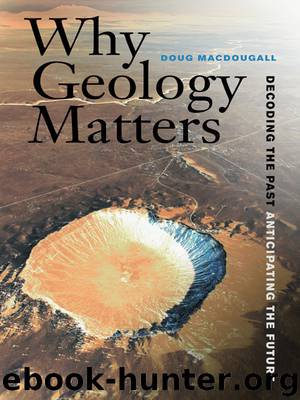Why Geology Matters: Decoding the Past, Anticipating the Future by Doug Macdougall

Author:Doug Macdougall
Language: eng
Format: epub
Publisher: University of California Press
CHAPTER EIGHT
Cold Times
The ice ages near the end of the Proterozoic eon were undoubtedly the most severe glacial periods ever to affect our planet. But these frigid intervals happened so long ago that we know only their broad outlines and will never be able to fill in many of the fine details. We don't know, for example, the exact configuration of the ice sheets, whether the glaciers waxed and waned repeatedly during the ice ages, how thick the ice was, or the extent of sea level fall and rise in response to glacier formation and melting. But we do know all this and more about a much more recent ice age, one that has influenced humans directly, affecting our landscapes, our climate, and even our evolution. The knowledge accumulated about this recent ice age has given us deep insight into how the Earth's climate system operates, and has made it easier to interpret the clues left in the geological record by ice ages of the distant past. It also provides ground truth for understanding how the climate system may respond to future perturbations.
This recent ice age is usually referred to as the “Pleistocene Ice Age,” a name that is slightly confusing. The Pleistocene is a subdivision of the geological timescale that lasted from 1.8 million until 11,400 years ago, yet the Pleistocene Ice Age began earlier, about three million years ago, and has continued right up to the present. On average over this time, the Earth has been much colder than it is today. Certainly, the dominant theme throughout the Pleistocene was glaciation, but there were also warm periods when the climate was at least as mild as it is at present. One of the insights gained from research into the Pleistocene Ice Age is that it is a period of constantly fluctuating temperatures, with long, cold glacial periods, when ice has covered as much as 30 percent of the Earth's surface, interspersed with shorter, much warmer intervals. In the absence of other influences—like the effects of humans—this pattern would be expected to continue, with the current warm interval ending and the Earth cooling again into the next glacial period.
When you come across the term the last ice age, it often refers only to the most recent cold glacial interval, not the Pleistocene Ice Age as a whole. In this book I will always try to make the distinction between the ice age—the entire time period—and the glacial and interglacial intervals within it. The Earth began to cool into the most recent glacial interval of the Pleistocene Ice Age about 125,000 years ago, and the coldest point in that interval was about 20,000 years ago. At that time, which geoscientists refer to as the “Last Glacial Maximum” (LGM), thick glaciers in North America extended far south of Chicago.
Nearly all of the evidence concerning glacial advances and retreats during the Pleistocene Ice Age comes from the Northern Hemisphere. Before about three million years ago, as far as we can tell, even
Download
This site does not store any files on its server. We only index and link to content provided by other sites. Please contact the content providers to delete copyright contents if any and email us, we'll remove relevant links or contents immediately.
Man-made Catastrophes and Risk Information Concealment by Dmitry Chernov & Didier Sornette(5951)
The Revenge of Geography: What the Map Tells Us About Coming Conflicts and the Battle Against Fate by Kaplan Robert D(4052)
Zero Waste Home by Bea Johnson(3804)
COSMOS by Carl Sagan(3585)
Good by S. Walden(3516)
In a Sunburned Country by Bill Bryson(3506)
The Fate of Rome: Climate, Disease, and the End of an Empire (The Princeton History of the Ancient World) by Kyle Harper(3030)
A Wilder Time by William E. Glassley(2833)
Camino Island by John Grisham(2778)
Organic Mushroom Farming and Mycoremediation by Tradd Cotter(2660)
The Ogre by Doug Scott(2657)
Human Dynamics Research in Smart and Connected Communities by Shih-Lung Shaw & Daniel Sui(2479)
Energy Myths and Realities by Vaclav Smil(2461)
The Traveler's Gift by Andy Andrews(2433)
9781803241661-PYTHON FOR ARCGIS PRO by Unknown(2341)
Inside the Middle East by Avi Melamed(2325)
Birds of New Guinea by Pratt Thane K.; Beehler Bruce M.; Anderton John C(2235)
A History of Warfare by John Keegan(2210)
And the Band Played On by Randy Shilts(2163)
